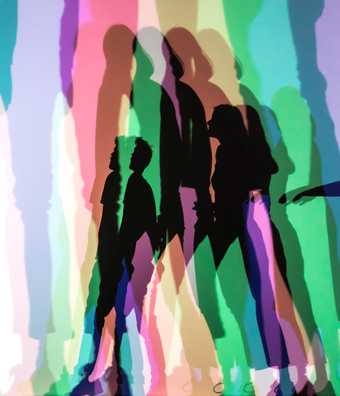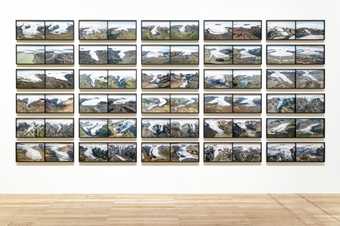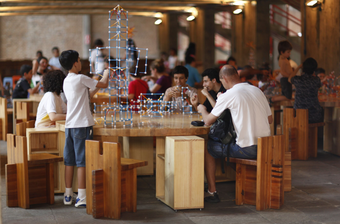Introduction
This exhibition brings together over 40 works of art made between 1990 and today by the Danish-Icelandic artist Olafur Eliasson. Born in 1967, Eliasson has created a broad body of work that includes installations, sculptures, photography and paintings. The materials he uses range from moss, glacial melt-water and fog, to light and reflective metals. Eliasson’s art comes from three particularly important interests. These are: his concern with nature, honed through his time spent in Iceland; his research into geometry; and his ongoing investigations into how we perceive, feel about and shape the world around us.
Eliasson puts experience at the centre of his art. He hopes that as you encounter it, you become more aware of your senses. You add meaning to the works as you bring your associations and memories to these experiences. You might also become more aware of the people around you with whom you form a temporary community. For Eliasson, this heightened awareness of yourself and other people creates a new sense of responsibility. Ultimately, he believes that art can have a strong impact on the world outside the museum.
Eliasson runs a studio in Berlin with technicians, architects, archivists, art historians, designers, filmmakers, cooks, and administrators. Exhibitions and commissions take place all over the world. Eliasson and his studio team collaborate with architects, policymakers, chefs, activists, musicians and choreographers. Developing from his interest in light and in the environment, Eliasson has launched projects addressing sustainable energy and the climate emergency. In the last part of this exhibition, you can discover how these projects emerge from the research that takes place in the studio. Downstairs in Tate’s Terrace Bar, you can also sample the organic vegetarian dishes developed in collaboration with the chefs at Eliasson’s studio. There is no fixed route through the exhibition. The works can be experienced in any order, but the map will help you navigate. More information on the works in the exhibition is on www.olafureliasson.net
Please note, BIG BANG FOUNTAIN includes flashing lights.
#OlafurEliasson
Model Room
This case contains around 450 models, prototypes and geometric studies of various sizes. Together, they form a record of Olafur Eliasson’s work with his studio team and with Icelandic artist, mathematician and architect Einar Thorsteinn (1942–2015).
Between 1996 and 2014 Thorsteinn and Eliasson collaborated on several projects and researched the geometric forms, symmetries and ratios that structure a number of Eliasson’s sculptures and pavilions. One of the modular shapes you see here, for example, is a study for Your spiral view 2002 which is installed in this exhibition.
These models are made from different materials including copper wire, cardboard, paper photocopies, Lego, wood, foam and rubber balls. For many years, they served as a reference ‘library’ for Studio Olafur Eliasson. Now, Model room is held at Moderna Museet, Stockholm, but the studio, and particularly its design and geometry teams, continues to create models and prototypes as part of its research.
Early works
This room brings together many of Eliasson’s earliest works and reveals interests that continue to motivate his art today.
Window projection 1990, Wannabe 1991 and I grew up in solitude and silence 1991 were made while Eliasson was still at art school. They use different kinds of light to alter the experience of space and architecture. As with many of Eliasson’s works of this time, the mechanism is very simple and never concealed from view.
Eliasson has long been interested in nature and the weather. From the start, he connected his experiences of the Icelandic landscape to the practice of making sculpture. Some works like Wavemachines 1995 replicate natural phenomena. Other works such as Regenfenster (Rain window) 1999 recreate the effects of weather conditions. In Moss wall 1994, created from Scandinavian reindeer lichen, Eliasson adds an unexpected material from outdoors to the controlled indoor space of the museum. The aroma and texture of the work affect the senses too.
These interests in illumination, nature and perception also led to early installations, such as Beauty 1993 and No nights in summer, no days in winter 1994 that you can find in the two spaces beyond this room.
Kaleidoscopes
Eliasson has been making kaleidoscopes since the mid-1990s. In this room, an older work, Your spiral view 2002 and a recent work Your planetary window 2019 are brought together.
For the artist, the kaleidoscope offers more than just a playful visual experience. Multiple reflections fracture and reconfigure what you see. You are offered different perspectives at once, and understand your position in new ways. You might let go of the sense of being in command of space, and instead enjoy a kind of uncertainty. Eliasson often uses the kaleidoscope to bring together the space inside and outside an exhibition. The appearance of both changes as the boundary between the gallery and the world outside is dissolved.
Eliasson has made a series of hanging spheres including the two outside the exhibition and a new work, In real life 2019 here. Each is structured by a complex yet regular geometric principle. The artist is particularly interested in spirals, as they create a sense of energy within the object and outside it through the shadow and light play on the surrounding walls.
Glacial works
Eliasson often uses glacial ice in his work. Sometimes, the ice is intended as a call for action against the climate emergency. Warmer climates have caused the Greenland ice sheet to lose around 200–300 billion tonnes of glacial ice each year, a rate that is expected to increase dramatically. Ice Watch, which was staged in front of Tate Modern in 2018, is an installation of ice blocks fished from the water off the coast of Greenland. It offered a direct and tangible experience of the reality of melting Arctic ice.
Other works, like those in this room, are a more abstract reference to the changing environment. In Glacial currents 2018, chunks of glacial ice were placed on top of washes of coloured pigment. This created swells and fades of colour as they melted onto the paper beneath. In The presence of absence pavilion 2019, a bronze cast makes visible the empty space left by a block of glacial ice that melted away. Glacial spherical flare 2019 is constructed with glass made from small rock particles created by glacial erosion.
Iceland
Eliasson visited Iceland regularly in his childhood and still has a strong connection to the country’s landscape. Over the years he has created photographic series that document the country. He has described Iceland as a place he needs to engage with physically – by climbing, walking, swimming or even water rafting. He took the photographs in The river-raft series 2000 from a raft as it was swept downstream.
Spending time in Iceland means Eliasson has witnessed firsthand how global warming is causing its glaciers to melt. This room includes a series of photographs of Iceland’s glaciers photographed by Eliasson in 1999. This will be joined in the autumn by a brand-new series taken in 2019 which show the changes in this landscape that are happening now.
Eliasson’s time in Iceland also attuned him to atmospheric conditions. This led to his interest in how artists have captured light throughout history. In Colour experiments 2019, Eliasson analysed the colour palettes of two paintings by German artist Caspar David Friedrich (1774–1840) that depict the vastness of nature: Der Mönch am Meer (The Monk by the Sea) 1808–10, and Der einsame Baum (The Lonely Tree) 1822. Each painting was abstracted into all the colours it contains. These were then distributed 93 proportionately around each canvas to form an alternative colour wheel.
Dividing this room from the next is Suney 1995, an early example of Eliasson’s interest in colour, architecture and perception.
The Expanded Studio
For some time, Eliasson’s practice has extended beyond making artworks, exhibitions, and public sculptures. He has worked – with his studio and with outside collaborators – on architectural projects, a cookbook, an art school, and on dance projects. He has founded an architectural practice, called Studio Other Spaces, with his long-time collaborator Sebastian Behmann, and initiated projects directly addressing issues facing the world today. These include projects to do with renewable energy (Little Sun), climate change (Ice Watch) and migration (Green light – An artistic workshop). These build on Eliasson’s long-held interests in the environment, light and community that led him to make the kinds of works in this exhibition.
The Expanded Studio evokes the broader interests and activities that Eliasson’s studio in Berlin pursues. The long pin-board wall here is based on the walls in the studio where teams of researchers and craftspeople, as well as Eliasson himself, share questions, articles, images and news clippings. The materials here are arranged around keywords in alphabetical order.
There are also films showing some of these projects in action – Little Sun, Green light and Ice Watch – as well as impressions of his architectural projects and of life in his studio. You can watch these films at home at www.soe.tv.
On the circular table, you will find Eliasson’s work The structural evolution project, first staged in 2001. Using Zometool sticks and connectors, you can collaborate to build and rebuild structures and shapes. Every other Wednesday, there will be a live link up with the studio showing daily life and a range of projects and activities taking place there.
Ice Watch
For Ice Watch, Eliasson and geologist Minik Rosing install blocks of glacial ice in public places.
The ice is fished out of the Nuup Kangerlua fjord in Greenland after becoming detached from the ice sheet. As a result of global warming, more icebergs are being produced, which is contributing to rising sea levels. Warmer climates have caused the Greenland ice sheet to lose around 200–300 billion tonnes each year, a rate that is expected to increase dramatically. Eliasson and Rosing hope that Ice Watch will raise awareness of the climate emergency by providing a direct and tangible experience of the reality of melting artic ice. Visitors can look at it, move around it and touch it.
Ice Watch was first installed at City Hall Square, Copenhagen in 2014, to mark the publication of the UN IPCC’s Fifth Assessment Report on Climate Change. In 2015 it was shown at Place du Panthéon to mark the publication of the UN IPCC’s Fifth Assessment Report on Climate Change. The third version of Ice Watch was on view from December 2018 to early January 2019 at two locations in London – outside Bloomberg’s European headquarters and in front of Tate Modern.
When they were installed outside Tate Modern, each of the ice blocks weighed between 1.5 and 5 tonnes. The carbon cost for bringing the 30 blocks of ice to the two sites in London was approximately equal to flying two school classes (52 students) from London to Greenland and back to witness the melting of the Greenland ice sheet. In comparison, hundreds of thousands of visitors experienced Ice Watch in London and connected with the issue of the climate emergency.
Architecture
Eliasson’s interests in movement, light and space have led him to create many large-scale installation works, as seen in this exhibition. Early in his career he also began working on free-standing structures and pavilions. Eliasson hopes his geometric experimentation will help us create new forms that challenge the usual ways of building and moving about spaces.
Over the years, this multidisciplinary approach has grown in size and scope. It includes works such as Your rainbow panorama 2006–11, located on top of ARoS, Aarhus Art Museum in Denmark; the facades of Harpa Reykjavik Concert Hall and Conference Centre in Iceland 2005–11, created with Henning Larsen Architects; and Cirkelbroen (Circle bridge) 2015, a pedestrian bridge in central Copenhagen.
Fjordenhus 2009–18, in Vejle, Denmark, was the first full building that Eliasson and his studio designed with his long-time collaborator, architect Sebastian Behmann. The building is constructed entirely around circles and curves. Every detail was planned by Eliasson and the studio, down to the tables and lamps and the patterns of the bricks. In 2014 Eliasson and Behmann set up an architectural office, Studio Other Spaces, to focus especially on large-scale projects that span art and architecture.
Studio Olafur Eliasson Kitchen at the Terrace Bar
Please visit the SOE Kitchen at the Terrace Bar downstairs. Soups, salads, bread and cakes based on those served in the studio are available, and the Terrace Bar has been transformed to reflect the atmosphere of Eliasson’s kitchen in Berlin. You are invited to eat, family-style, at tables similar to the studio’s, surrounded by artworks and lamps by Eliasson.
The Terrace Bar is hosting a public programme on subjects such as sustainability and community, and practical workshops on fermentation, baking and preservation. A schedule and further information can be found at SOE Kitchen at the Terrace Bar.




